Goddard Coats of Arms
by Brian Goddard, Newbury, England, 4. Jan. 2005
 To the
left is an
invitation card of the original Goddard Association, printed in 1664,
before the Great Fire of London in 1666 when the street and church
mentioned in it were destroyed.
The original was engraved on copper, probably by John Goddard, an artist and engraver of the period, some of whose other work contains the same characteristics. The invitation is as follows:-
To the
left is an
invitation card of the original Goddard Association, printed in 1664,
before the Great Fire of London in 1666 when the street and church
mentioned in it were destroyed.
The original was engraved on copper, probably by John Goddard, an artist and engraver of the period, some of whose other work contains the same characteristics. The invitation is as follows:-
“There is
a friendly meeting of those whose surnames be Goddard. Sr. your company
is lovingly desyred only for socyetie and acquaintance. The times of
meeting are the 9th day of every month in ye yeare except it be Sunday
when on ye day following from Ladey day to Michaelmas at six and from
Michaelmas to Ladey day at 4 o'clock in the afternoone at the Red Bull
behind St Nicholas Shambles called Mount Goddard Streete”.
This "curious
printed document" was first noticed by Richard Jefferies in "A memoir of the Goddards of North Wilts."
published about 1873 in Coate, Swindon, Wiltshire, England and is
reproduced from the only known original which was at "The Lawn" Swindon.
In 1903 Mr. Rainald William Knightley Goddard of Denmark Hill, London,
England, was loaned the framed "document" by the late Major Fitzroy
Pleydell Goddard, then living at "The Lawn". An electrical process cut
was made by Mr. Frederick Arthur Crisp, a friend and neighbour of Mr.
Goddard, who printed the first reproduction in "Fragmenta Genealogica",
Vol. IX, London, 1903.
These locations were intimately described by John
Stow in his "Survey of London", 1590. "The Shambles" is noted on an old
map of London, between the present General Post Office and St. Paul's
Cathedral.
__________________________________________________________
Faringdon Ward Within, as described in the year
1593
"Yet
begin again at the said Conduit by the Old Exchange, on the north side
therof is a large street that runneth up to Newgate, as is aforesaid.
The first part, or south side whereof, from the Conduit to the shambles,
is called Bladder Street. Then on the back side of the shambles be
divers slaughter-houses, and such like, pertaining to the shambles; and
this is called Mount Goddard Street, Then this is the shambles itself,
and then Newgate market; and so the whole street, on both sides up to
Newgate, is of this ward; and is thus dully bounded."
"Now
again from the conduit by Paule's gate on the north side is a large
street running west to Newgate, the first part whereof, from the conduit
to the shambles, is of selling bladders there, called Bladder Street.
Then behind the butchers' shops be now divers slaughter houses inwards
and tippling houses outward, This is called Mountgodard street of the
tippling houses there, and the goddards 1 mounting from the tap to the
table, from the table to the mouth, and sometimes over the head. This
street goeth up to the north end of Ivie lane. Before this Mountgodard
street stall boards were of old time set up by the butchers to show and
sell their flesh meat upon, over the which stallboards they first built
sheds to keep off the weather; but since that, encroaching by little and
little, they have made their stallboards and sheds fair houses, meet for
the principal shambles". 2
Click here for more information on Mount Godard Street
from pre 1600 London
__________________________________________________________
Amongst others, the
armorial bearings of Goddard families in Wiltshire, Leicestershire,
Norfolk, Cheshire, Hampshire and Kent are shown on stylised shields, as
well as those of the Star-chamber courts and a lawyer from Salisbury.
Fitzroy Pleydell Goddard (d.1927) had photographs taken of the original
advertisement which is kept in the British Museum. Eighteen coats of
arms are shown and two monograms embodying the five letters forming the
family name. In heraldry, the simplest design of both the shape of the
shield and the design of the arms usually mean the design is of the
earliest date. But as depicted here there is much “artistic licence”
used to balance the design of the card that one cannot judge the age of
the arms. However, the use a funereal setting for the Salisbury and the
Kent arm leads to the speculation that they were extinct before 1664
 If
one ignores the “eagle displayed” of the Court of the Star Chamber
(abolished in 1641), which was frequently added to arms as a badge of
office or rank for lawyers and not passed on from generation to
generation. An exception to this seems to be arms of a Goddard family of
several generations of lawyers and merchants of Stanhoe Norfolk and
London whose arms are displayed above the label “NORFORD”. Of the 3
distinct coats of arms for the Goddard families, two of these arms, the
three crescents of Wiltshire and the three hawks heads of Leicestershire
are found quartered together on one shield on the memorial to Thomas
(died 1597) in Aldbourne church and on a pillar in Castle Eaton church
dated 1704.
If
one ignores the “eagle displayed” of the Court of the Star Chamber
(abolished in 1641), which was frequently added to arms as a badge of
office or rank for lawyers and not passed on from generation to
generation. An exception to this seems to be arms of a Goddard family of
several generations of lawyers and merchants of Stanhoe Norfolk and
London whose arms are displayed above the label “NORFORD”. Of the 3
distinct coats of arms for the Goddard families, two of these arms, the
three crescents of Wiltshire and the three hawks heads of Leicestershire
are found quartered together on one shield on the memorial to Thomas
(died 1597) in Aldbourne church and on a pillar in Castle Eaton church
dated 1704.
It is remarkable that the
three crescent coat of arms is so widespread over the southern half of
England, but only one example in Scotland. These arms are often
associated with apparently unrelated family groups, differing in detail
only for their choice of colour for the crescents. Gold, silver, mink
and vair (grey squirrel), are represented on the above card. There are
other variations of the crests and/or supporters found on the full
versions of the arms.
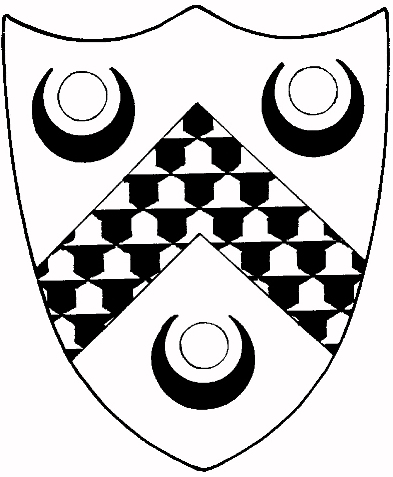
Of particular interest is a seal ring, (image 3 on the left), first
mentioned in the will of Henry Goddard of Staple Fitzpaine in Somerset,
died 1662, depicting the three crescent coat of arms and it is virtually
identical to the arms of the Wiltshire Goddards.
Most of the
senior members of Staple Fitzpaine family emigrated to Barbados in the
early half of the 17th century owning and running sugar plantations. But
the real interest, at this time, lies in why this ring stayed in
England, with the junior wing of the family, to be handed down through
to the present generation. The reason for this is as yet unknown.
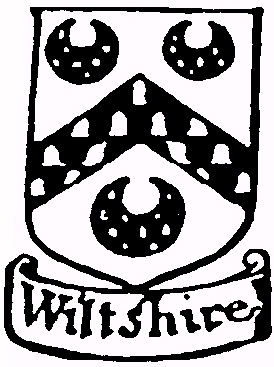
Only
the North Wiltshire Goddards are presently entitled to bear arms, none
of the other families have survived through the male line. The arms of
the present Wiltshire branch of the family are:- a chevron vair between
3 crescents argent crested Gules, a stag's head affronte, couped at the
neck, gules, attired or, and the motto “Cervus non Servus”. The motto of
the Wiltshire families, “Cervus non Servus” is a punning one and may be
a recent addition, probably Victorian, although many are much older but
this motto is not mentioned in any of the visitations.
The
arms of the Leicestershire, Lincolnshire and London branches are
variations based on:- azure,
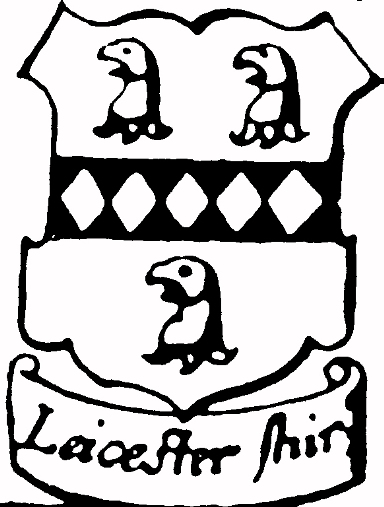 a fess indented between 3 hawks heads
erased or. This family has not maintained a male line and therefore the
arms are now defunct. The of the arms of a Hampshire Goddard family and
that of other closely related families are not illustrated on the
advertising card but their description in the Herald's visitation of
1565 shows that there had been a family intermarriage, as the East Woodhay and Castle Eaton family arms were described as:- “Quarterly, 1
and 4 gules, a chevron vair between 3 crescents argent. 2 and 3 azure, a
fess indented between 3 hawks heads erased or”.
a fess indented between 3 hawks heads
erased or. This family has not maintained a male line and therefore the
arms are now defunct. The of the arms of a Hampshire Goddard family and
that of other closely related families are not illustrated on the
advertising card but their description in the Herald's visitation of
1565 shows that there had been a family intermarriage, as the East Woodhay and Castle Eaton family arms were described as:- “Quarterly, 1
and 4 gules, a chevron vair between 3 crescents argent. 2 and 3 azure, a
fess indented between 3 hawks heads erased or”.
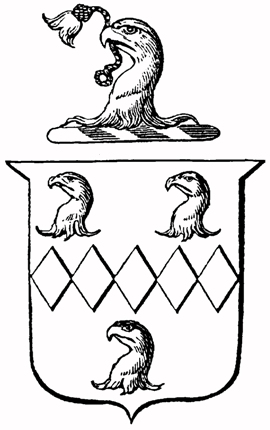 Arms.-
Az. A fess of five lozenges, betw. three hawks heads erased, or.
Arms.-
Az. A fess of five lozenges, betw. three hawks heads erased, or.
-
Crest.
- a hawks head or, holding in the beak a leure gu. capped vert,
garnished of the first stringed of the second.
-
A patent of
these arms and crest granted by Christopher Barker, Garter King of Arms
to William Goddard 3d December 1536.
According to
the Heralds Visitation in 1566 for the Yate of Longworth family, (a John
Yate married Joan Goddard, daughter of Richard of Upham in about 1500),
the Yate arms are quartered with the Wiltshire crescents. But a similar
report of 1665 for Yate, now “of Buckland”, shows the addition of the
Goddard hawks head arms, with others to the Yate arms. There is a
specific note on the report that the hawks head arms were ancient when
compared with the three crescent arms. Other reports from the Heralds
Visitations state that the arms were granted to William Goddard of
London, (3rd son of Richard of Ogbourne), in 1536. However, it is
probable that the hawks head arms are much older and that possibly
William was not a direct, or the obvious heir to the branch that then
owned them.
The arms from
Salisbury look to be variations on those of Leicestershire and London,
the owner was certainly a lawyer and possibly one who had moved from
London for only part of his life. The only Goddards for whom records
have been found in Salisbury are for tradesmen, cutlers and grocers, and
then not until the 18th century.
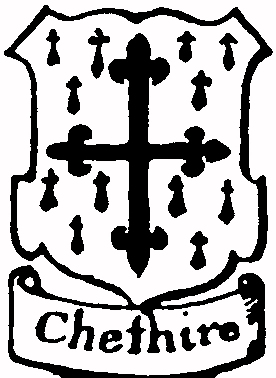 The
present view of the last group of arms, consisting of the “cross fleurie
or patonce” on a background of ermine, is that they are the oldest,
pre-dating the hawks head arms. The crescents being the youngest arms,
these symbols are often associated with the Middle East and the Crusades
and are, at this time, thought to be originally from Holland. The
“cross fleurie or patonce” arms were brought over from Normandy by Sir
Hugh Godarville and subsequently passed on to his sons, Sir Hugh and Sir
Walter and are possibly circa 1200A.D.
The
present view of the last group of arms, consisting of the “cross fleurie
or patonce” on a background of ermine, is that they are the oldest,
pre-dating the hawks head arms. The crescents being the youngest arms,
these symbols are often associated with the Middle East and the Crusades
and are, at this time, thought to be originally from Holland. The
“cross fleurie or patonce” arms were brought over from Normandy by Sir
Hugh Godarville and subsequently passed on to his sons, Sir Hugh and Sir
Walter and are possibly circa 1200A.D.
This coat of
arms could possibly be derived from cross of the arms of the de Vesci
family on a background of the ermine shield of Brittany It appears that
only the three crescent arms are in current use, the last known use of
the Goddard “cross patonce” was on the visiting card of 1664. This fits
in with the knowledge that Sir Hugh was a “Marcher Baron” brought from
Brittany in the latter half of the 12th century to control the Welsh
Borders, and we also have evidence that he had land in Kent and also
probably in Norfolk. In addition to taking over his fathers arms, the
grandson of the Sir Hugh Godarville took over all the duties as a knight
of Edward I. This included being sent on missions to Scotland, Ireland
and Gascony. There is fragmentary evidence to show that this family
became lawyers through to possibly the early part of 18th century, in
London, but emanating from the eastern area of England. The arms of the
“cross fleurie or patonce” coupled with “eagle displayed” were the arms
of Sir Richard Goddard who was born in Buckingham and an alderman of
London who died in 1604, but he died without children and the trail of
these arms has been lost for the present. 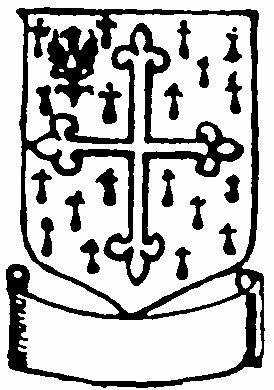
Much more
research is required on the armourial bearings of Goddard families
before there is a clear picture of the derivation of these coats of
arms. The Royal College of Arms would be pleased to carry out further
research for the Goddard Association, but this would be an expensive
exercise and then of only academic value.
-
A
goddard - a drinking cup or goblet – often pottery. Oxford English
Dictionary – banned as a unit of measure in Leicester in 1520.
-
Two extracts from Stows Survey of London 1593
-
Information from Keith Goddard of Sydney Australia. Note – Roundels
are thought to be of no heraldic significance Curiae Regis Rolls
 To the
left is an
invitation card of the original Goddard Association, printed in 1664,
before the Great Fire of London in 1666 when the street and church
mentioned in it were destroyed.
The original was engraved on copper, probably by John Goddard, an artist and engraver of the period, some of whose other work contains the same characteristics. The invitation is as follows:-
To the
left is an
invitation card of the original Goddard Association, printed in 1664,
before the Great Fire of London in 1666 when the street and church
mentioned in it were destroyed.
The original was engraved on copper, probably by John Goddard, an artist and engraver of the period, some of whose other work contains the same characteristics. The invitation is as follows:-
 If
one ignores the “eagle displayed” of the Court of the Star Chamber
(abolished in 1641), which was frequently added to arms as a badge of
office or rank for lawyers and not passed on from generation to
generation. An exception to this seems to be arms of a Goddard family of
several generations of lawyers and merchants of Stanhoe Norfolk and
London whose arms are displayed above the label “NORFORD”. Of the 3
distinct coats of arms for the Goddard families, two of these arms, the
three crescents of Wiltshire and the three hawks heads of Leicestershire
are found quartered together on one shield on the memorial to Thomas
(died 1597) in Aldbourne church and on a pillar in Castle Eaton church
dated 1704.
If
one ignores the “eagle displayed” of the Court of the Star Chamber
(abolished in 1641), which was frequently added to arms as a badge of
office or rank for lawyers and not passed on from generation to
generation. An exception to this seems to be arms of a Goddard family of
several generations of lawyers and merchants of Stanhoe Norfolk and
London whose arms are displayed above the label “NORFORD”. Of the 3
distinct coats of arms for the Goddard families, two of these arms, the
three crescents of Wiltshire and the three hawks heads of Leicestershire
are found quartered together on one shield on the memorial to Thomas
(died 1597) in Aldbourne church and on a pillar in Castle Eaton church
dated 1704. 

 a fess indented between 3 hawks heads
erased or. This family has not maintained a male line and therefore the
arms are now defunct. The of the arms of a Hampshire Goddard family and
that of other closely related families are not illustrated on the
advertising card but their description in the Herald's visitation of
1565 shows that there had been a family intermarriage, as the East Woodhay and Castle Eaton family arms were described as:- “Quarterly, 1
and 4 gules, a chevron vair between 3 crescents argent. 2 and 3 azure, a
fess indented between 3 hawks heads erased or”.
a fess indented between 3 hawks heads
erased or. This family has not maintained a male line and therefore the
arms are now defunct. The of the arms of a Hampshire Goddard family and
that of other closely related families are not illustrated on the
advertising card but their description in the Herald's visitation of
1565 shows that there had been a family intermarriage, as the East Woodhay and Castle Eaton family arms were described as:- “Quarterly, 1
and 4 gules, a chevron vair between 3 crescents argent. 2 and 3 azure, a
fess indented between 3 hawks heads erased or”.  Arms
Arms The
present view of the last group of arms, consisting of the “cross fleurie
or patonce” on a background of ermine, is that they are the oldest,
pre-dating the hawks head arms. The crescents being the youngest arms,
these symbols are often associated with the Middle East and the Crusades
and are, at this time, thought to be originally from Holland. The
“cross fleurie or patonce” arms were brought over from Normandy by Sir
Hugh Godarville and subsequently passed on to his sons, Sir Hugh and Sir
Walter and are possibly circa 1200A.D.
The
present view of the last group of arms, consisting of the “cross fleurie
or patonce” on a background of ermine, is that they are the oldest,
pre-dating the hawks head arms. The crescents being the youngest arms,
these symbols are often associated with the Middle East and the Crusades
and are, at this time, thought to be originally from Holland. The
“cross fleurie or patonce” arms were brought over from Normandy by Sir
Hugh Godarville and subsequently passed on to his sons, Sir Hugh and Sir
Walter and are possibly circa 1200A.D. 